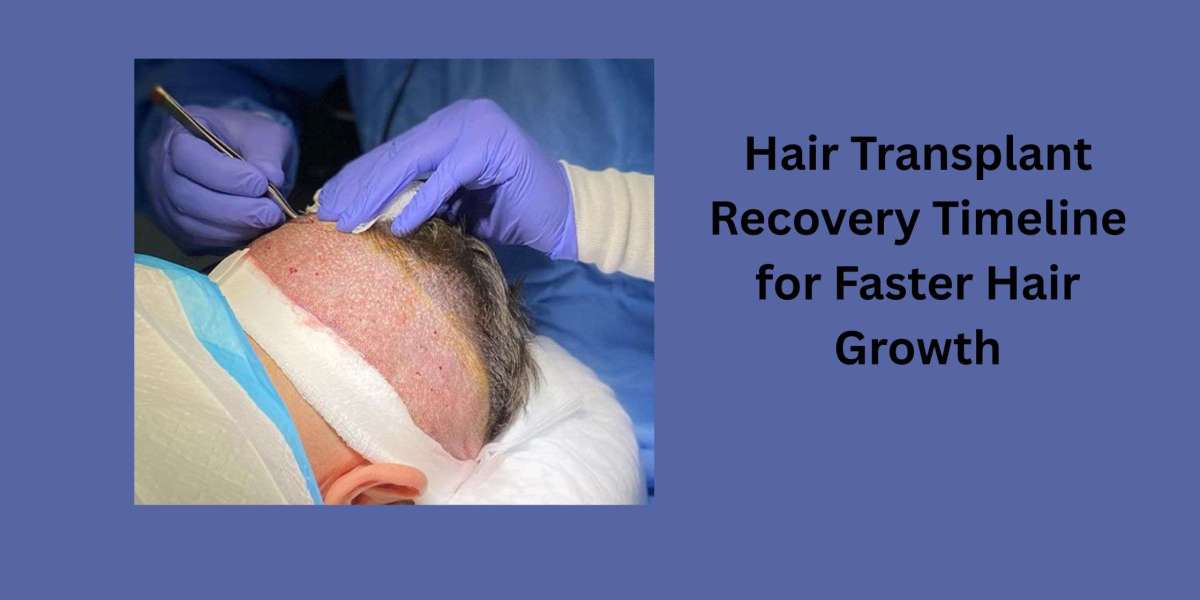Undergoing a hair transplant is an effective step towards restoring self-assurance and achieving a fuller head of hair. However, the procedure's success doesn't end in the operating room; it continues through a meticulous recovery process. This comprehensive guide summarises the hair transplant recovery timeline, offering insights and tips to promote faster hair growth. Understanding this timeline is crucial for optimal results if considering a procedure.
Week 1: Initial Healing and Care
What to Expect:
- Scabbing and Redness: Small scabs will form around the transplanted follicles within the first few days post-surgery. This is a natural part of the healing process.
- Swelling: Some patients may experience mild swelling in the forehead and around the eyes, typically subsiding within a few days.
- Sensitivity: The scalp may feel tender, and there might be a sensation of tightness.
Care Tips:
- Avoid Touching: Avoid touching or scratching the transplanted region to stop dislodging grafts.
- Sleeping Position: Sleep with your head raised to minimize swelling.
- Gentle Washing: Follow the instructions provided by your surgeon regarding when and how to wash your hair, typically commencing 48 hours after surgery.
Our clinic offers comprehensive aftercare guidelines to help patients manage this important stage effectively.
Weeks 2-4: Shedding Phase
What to Expect:
- Shock Loss: Transplanted hairs may begin to shed—a normal occurrence known as "shock loss." This is temporary, and the follicles remain healthy beneath the scalp.
- Reduced Redness: The redness and scabbing will diminish, and the scalp will look more normal.
Care Tips:
- Continue Gentle Washing: Maintain a gentle washing routine as your surgeon advises.
- Avoid Sun Exposure: Protect your scalp from direct sunlight to prevent damage to the healing follicles.
- No Harsh Chemicals: Avoid using hair products containing alcohol or other harsh chemicals.
Understanding this phase is essential for patients in Palm Desert, whose sunny climate necessitates diligent sun protection during recovery.
Months 1-3: Early Growth Phase
What to Expect:
- Dormant Period: After shedding, the follicles enter a resting phase. Visible growth may not be apparent during this time.
- Initial Regrowth: By the end of the third month, new hairs may emerge, appearing fine and thin.
Care Tips:
- Healthy Lifestyle: Maintain a well-rounded diet abundant in vitamins and minerals to promote hair growth.
- Avoid Stress: Stress can impact hair growth; meditation or yoga can be beneficial.
- Regular Check-ups: Attend subsequent appointments to track progress and resolve any issues.
Our clinic emphasizes this phase's importance and supports patients navigating the early stages of regrowth.
Months 4-6: Noticeable Growth
What to Expect:
- Increased Density: Hair growth becomes more noticeable with increased thickness and coverage.
- Improved Texture: New hairs begin to match the texture of existing hair, blending seamlessly.
Care Tips:
- Regular Hair Care: You can resume regular hair care routines, including gentle brushing and washing.
- Avoid Heat Styling: Limit heat styling tools to prevent damage to the new hair.
- Scalp Massage: Gentle scalp massages can promote blood circulation and support hair growth.
Patients in Palm Desert are advised to continue protecting their scalps from the sun and to consult with their surgeons before using new hair care products.
Months 6-12: Maturation Phase
What to Expect:
- Full Growth: By the end of this period, most patients see the full results of their hair transplant, with hair achieving its final thickness and length.
- Natural Appearance: The transplanted hair blends naturally with existing hair, allowing various styling options.
Care Tips:
- Regular Trims: Regular haircuts can help maintain the desired style and promote healthy hair.
- Continued Healthy Lifestyle: Ongoing attention to diet, stress management, and scalp care supports the longevity of the transplant results.
- Consultation: Schedule a final consultation to assess the outcome and discuss any additional treatments if necessary.
Beverly Hills Hair Restoration in Palm Desert offers comprehensive post-operative care, ensuring patients achieve the best possible outcomes from their hair transplant procedures.
Conclusion
Navigating the hair transplant recovery timeline requires patience, care, and adherence to post-operative instructions. Each phase, from initial healing to full maturation, is vital in achieving the desired results. Our clinic is a leading choice for individuals in Palm Desert looking for professional advice and high-quality care. Their commitment to patient education, personalized treatment plans, and ongoing support ensures everyone is well-equipped to experience a successful hair restoration journey.



